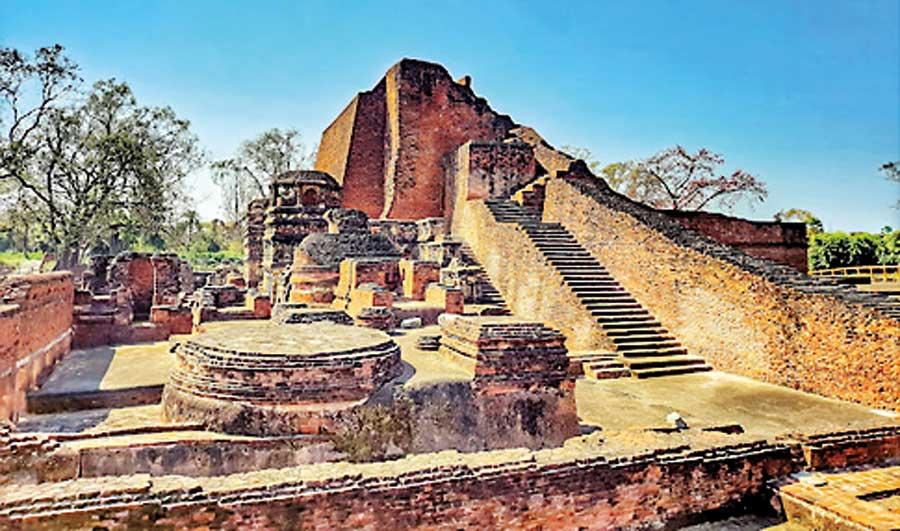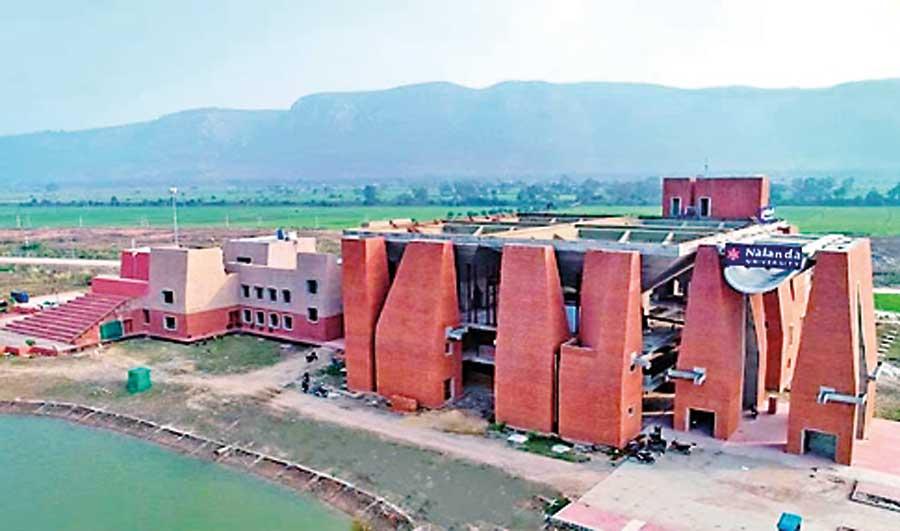Reply To:
Name - Reply Comment

Ruins of Nalanda Mahavihara

On June 19, a momentous and historic event took place in the North Indian State of Bihar. The governments of Bihar and India were reviving the glory ofNalanda Mahavihara,an ancient and world-renowned Buddhist university located in Rajagriha, now called Rajgir in Hindi.
Founded in 455 BC, the Nalanda Mahavihara functioned till 1193 AD when a Turko-Afghan invader Bakhtiyar Khilji set fire to it in a fit of iconoclastic rage.
At its peak, the Nalanda Mahavihara had, in residence, more than 10, 000 students and scholars from all over India and Asia. It is reputed to be the world’s first residential university.
On June 19, Indian Prime Minister Narendra Modi inaugurated the new campus of the Nalanda Mahavihara’s successor, the Nalanda University, an international University. Rather like the ancient Nalanda Mahavihara, the new university has students from India and 16 other countries including Sri Lanka, Laos, Mauritius, Myanmar, New Zealand, Portugal, Singapore, South Korea, Thailand, and Vietnam. The new campus is set in sylvan surroundings and care has been taken to see that the environment is not polluted.
The Indian Parliament established the new Nalanda University in 2010 based on decisions arrived at the second East Asia Summit held in the Philippines in 2007 for the establishment of the university as an “international institution for the pursuit of intellectual, philosophical, historical and spiritual studies”.
Presently, the university offers 137 scholarships to international students for Post Graduate and Doctoral research. It also offers short-term certificate courses. Nalanda University’s current Chancellor is the famous US-based economist Arvind Panagariya. Earlier, the Nobel Laureate Amartya Sen had adorned that chair.
Nalanda Mahavihara
Nalanda Mahavihara was set up by the Magadhan Emperor Kumaragupta I in 455 BC and was subsequently improved by Emperor Asoka who ruled Magadha from 268 to 232 BC. The university was patronised by various rulers including King Harshavardhana of Kannauj (in the 7th century AD) and the Buddhist Pala rulers of Bengal (from the 8th – 12th centuries AD).
Affirming that Bhakhtiyar Khilji had not been able to destroy the spirit of inquiry that the Nalanda Mahavihara embodied, Prime Minister Modi declared that its rebirth was a “proclamation of the truth that books may burn in the flames of fire, but the flames of fire cannot destroy knowledge.”
Rajgir or Rajagriha, is about 88 km from Patna, the capital of Bihar State. Rajagriha was intimately connected with the Buddha who chose to live there during many a rainy season. In Buddha’s time, Rajagriha was a thriving mercantile centre with merchants coming from many parts of India and neighbouring regions. Buddha’s rational philosophy appealed to the progressive Indian merchant class, which then carried his teachings to various parts of India and Asia.
According to Dr.Daya Hewavitharane, Nalanda is near the birthplaces of the Buddha’s two main disciples – Sariyuth (Saraputta) and Mugalan (Moggallana) Mahatheras. Soon after the Buddha’s passing away, a temple was built at Nalanda. Among the famous chancellors of the Nalanda Mahavihara were: Nagarjuna, Aryadeva, Asanga, Vasubandhu, Dinnaga, Dharmakirthi, Shantharakshita, Dharmapala and Shilabhadra. According to Dr.Hewavitharane, Aryadeva, the favourite disciple of Nagarjuna, hailed from Sri Lanka. The brothers Asanga and Vasubandhu (4th c.) were abbots in succession at Nalanda.
Modi Plants Bodi Sapling
Because of Rajgir’s Buddhist links, Prime Minister Modi planted a sapling of the Bodhi tree on the new campus. The sapling was brought from Buddha Gaya.
Speaking on the occasion, Modi said: “The renaissance of Nalanda University near its ancient ruins will introduce India’s potential to the world. Nalanda is not just a renaissance of India’s past, the heritage of many countries and Asia is linked to it. In days to come, Nalanda University will once again become a major centre for our cultural exchange.”
Discovery of Nalanda Mahavihara
It was about six centuries after Nalanda Mahavihara’s decline, that the site was discovered by Sir Francis Buchanan-Hamilton, a surgeon and naturalist in the employ of the East India Company, which ruled India then.
Though located in 1812, it was identified as the Nalanda Mahavira only in 1861 by Maj.Gen. Sir Alexander Cunningham an army officer turned archaeologist who founded the Archaeological Survey of India (ASI). The site was systematically excavated and consolidated much later in two phases, the first between 1915 and 1937 and the second, between 1974 and 1982.
The Nalanda Mahavihara distinguished itself as the earliest planned university in the Indian subcontinent. Students were admitted after rigorous evaluation. Apart from teaching topics directly related to Buddhism, contemporary texts and philosophies, logic, grammar, science, and medicine were also imparted.
Nalanda`s scholars mastered the art and science of debate, developing it into a critical tool for higher learning. Over time, the term Nalanda became synonymous with a high standard of education.
Preserved in the site are the structural remains of Viharas (residential-cum-scholastic structure) and Chaityas (temple-like structure). The Viharas retain the infrastructure for residential-cum-scholastic functions. The site also retains a corpus of moveable and immoveable artifacts and artistic embellishment that shows the iconographic development of the Buddhist belief system.
Importance of Science
In his 2011 lecture on the Nalanda Mahavihara at a science congress in Chennai, Nobel Laureate and economist Amartya Sen said the Nalanda Mahavihara attracted Chinese students like Xuanzang and Yi Jing, who came in the Seventh Century AD. They particularly admired the educational standards. Incidentally, Nalanda Mahavihara was the only non-Chinese institution in which any Chinese scholar was educated in the history of ancient China.
Amartya Sen said that intellectual Buddhism sought knowledge in many different fields. Some of these were directly related to Buddhist commitments, such as medicine and healthcare; others went with the development and dissemination of Buddhist culture, such as architecture and sculpture; and still others linked Buddhist intellectual queries with interest in analytical disciplines.
Tantric Buddhism, in particular, had an impact on Chinese mathematics and astronomy in the seventh and eighth centuries, in the Tang period. Yi Jing, who was a student of Nalanda Mahavihara, was one of many translators of Tantric texts from Sanskrit into Chinese.
According to Joseph Needham, “The most important Tantrist was the Buddhist monk, I-Hsing, the greatest Chinese astronomer and mathematician of his time (7th Century AD).
Nalanda Mahavihara was known for its openness. Sen notes that Xuangzang as well as Yi Jing mentioned the warm welcome they received as they arrived in Nalanda Mahavihara from China. When Xuangzang completed his studies at the Mahavihara, he was asked to stay back to be part of the faculty. He gladly agreed saying “Who would wish to enjoy knowledge alone, and to forget those who are not yet enlightened?”
The Nalanda Mahavihara was opposed to parochialism and rigid nationalism in the true spirit of science. “Science has to fight parochialism, and Nalanda was firmly committed to just that,” Sen said in conclusion.

The new Nalanda University